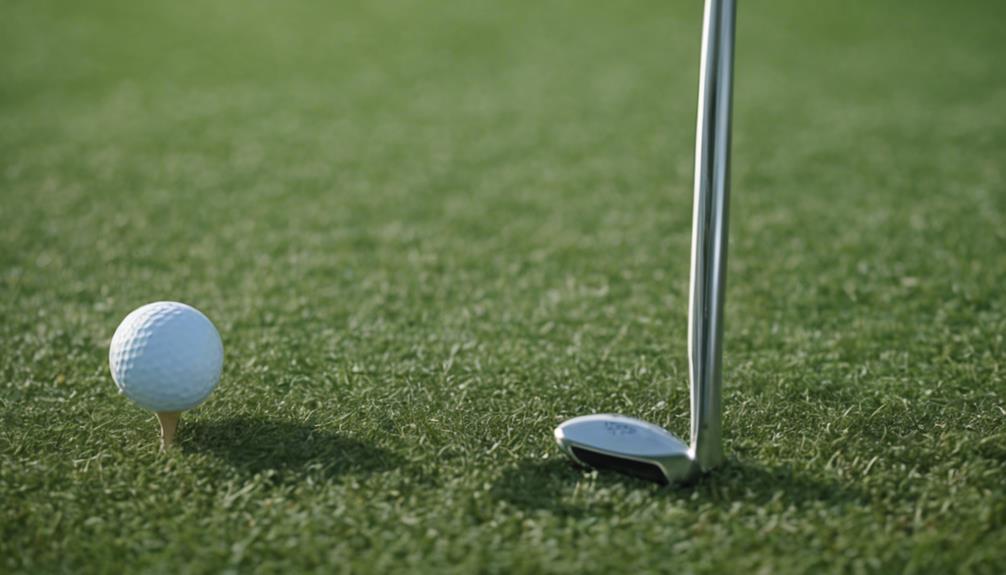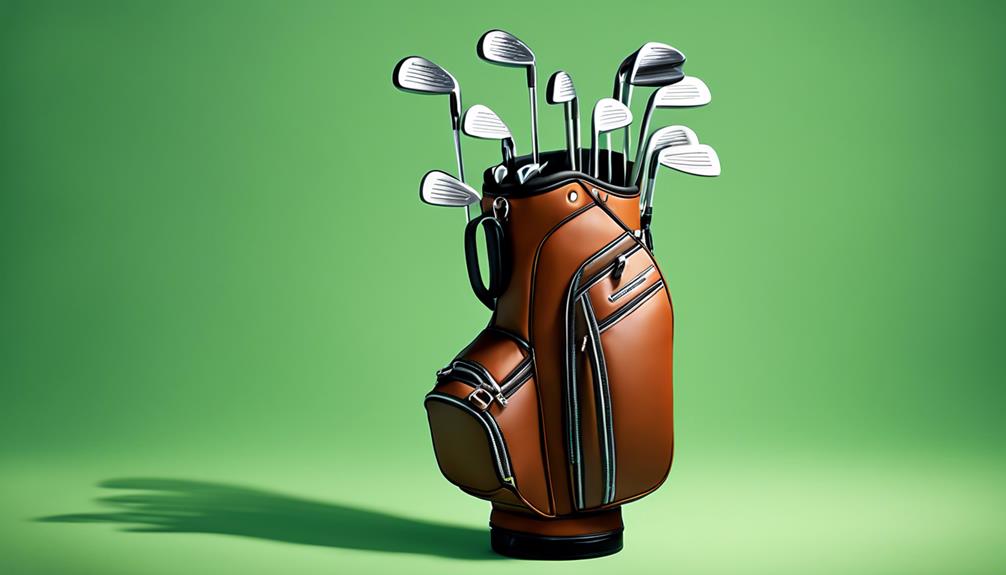- 7 Top Flite Golf Clubs XL for Improved Performance - September 28, 2024
- Top Flite Golf Clubs: Top 5 Reasons to Choose Them - September 28, 2024
- Top 3 Golf Club Fitters for a Perfect Swing - September 28, 2024
You'll achieve a consistent swing by identifying your unique swing characteristics, such as tempo, shift, and overall motion pattern. This understanding enables you to find the ideal golf club combination that harmonizes with your swing, leading to peak performance. Effective club fitting involves finding the right club, shaft, and configuration to suit your swing, which helps develop a consistent strike pattern and improves accuracy and distance. By grasping the nuances of driver and fairway wood combinations, wedge setup, iron selection, and launch characteristics, you'll be on the path to realizing your full potential – and there's more to explore to refine your game.
Key Takeaways
- Identifying unique swing characteristics, including tempo, shift, and overall motion pattern, is crucial for determining the ideal golf club combination.
- Understanding swing speed and its impact on distance and accuracy is vital for selecting the right clubs and achieving consistent performance.
- A well-fitted club helps develop a consistent strike pattern, leading to improved accuracy and distance, and is essential for a repeatable swing.
- Optimizing club fitting involves finding the right club, shaft, and configuration to suit the swing, and Trackman reports provide valuable insights to improve swing consistency.
- Harmony between the swing and clubs is key to achieving a consistent swing and peak performance, and requires consideration of factors such as shaft flex, head size, and loft angle variations.
Understanding Swing Characteristics
As you analyze your golf swing, identifying your unique swing characteristics – tempo, shift, and overall motion pattern – becomes essential in determining the ideal golf club combination that complements your game.
Understanding your swing speed, in particular, is vital, as it affects the distance and accuracy of your shots. Are you a slow swinger, averaging around 70-80 mph, or do you generate more power, reaching speeds of 100 mph or more?
Knowing your swing speed helps you choose clubs that match your strength and style. Additionally, examining your swing characteristics, such as the angle of attack, handover, and follow-through, reveals your overall motion pattern.
Do you have a smooth, controlled tempo or a more aggressive, dynamic motion? By recognizing these patterns, you can select clubs that work in harmony with your swing, rather than against it.
This harmony is key to achieving a consistent swing and peak performance on the course.
Driver Head and Shaft Pairing
Now that you've identified your swing characteristics, it's time to think about the specifics of your driver head and shaft pairing.
You'll need to ponder the ideal shaft flex, taking into account factors like torque and weight, to facilitate a smooth, consistent swing.
Additionally, you'll want to explore head size variations to find the perfect balance of forgiveness and workability for your game.
Shaft Flex Options
You'll need to carefully consider the shaft flex options for your driver head and shaft pairing, as the right combination can substantially impact your overall performance on the course. The key is to find a shaft that complements your swing speed and style.
| Swing Speed | Shaft Weight | Launch and Spin Profile |
|---|---|---|
| 106+ mph | 65-75 grams | Low launch and spin |
| 95-105 mph | 55-65 grams | Mid-launch and spin |
| 80-94 mph | 55-65 grams | Launch and spin dependent on swing characteristics |
| Under 80 mph | 39-50 grams | High launch and spin |
| Any speed | – | Smooth tempo recommended |
Head Size Variations
Optimizing your driver head size is essential, as it directly influences the overall forgiveness and workability of your drives, with larger heads generally suited for golfers who need more room for error.
When choosing a driver head, consider your skill level and swing characteristics.
If you're a beginner, a larger head (460cc) might be more forgiving and help you get the ball in play more often.
If you're an advanced player, a smaller head (440cc or 420cc) might provide more workability and precision.
If you have a faster swing speed, you might benefit from a smaller head with a stiffer shaft to reduce spin and increase distance.
Wedge Combinations for Consistency

When you're selecting a wedge combination, you'll need to weigh the gap wedge options that work best for your game.
You'll want to think about the loft angle variations that will provide you with the most consistent results, taking into account the 4-6 degree gap between wedges that's ideal for developing a sense of distance.
Gap Wedge Options
Golfers seeking consistency in their short game often turn to carefully selected wedge combinations, which can make all the difference in achieving precise distance control and mastering various shots around the green.
When it comes to gap wedge options, you'll want to weigh the loft gaps between your wedges. A good rule of thumb is to maintain a 4-6 degree gap between each wedge, allowing you to develop a better sense of distance and avoid confusion when selecting a wedge.
The 52* 56* 60* wedge combination provides a range of lofts for different shots and allows for more precise distance control.
The 53* 58* combination provides a slightly larger gap between wedges, which can be beneficial for golfers who prefer a more consistent swing and don't want to worry about adjusting swing speed.
A two-wedge setup, such as the 54-58 combination, can simplify the decision-making process around the green and allow you to focus on feel and trajectory rather than yardage.
Loft Angle Variations
By carefully selecting wedge combinations with consistent loft angle variations, you can develop a more consistent short game and improve your overall scoring.
A popular wedge setup is the 52°, 56°, 60° combination, which provides a range of lofts for different shots and allows for more precise distance control.
However, maintaining a consistent loft gap of 4-6 degrees between wedges is vital to develop a better sense of distance and consistency around the green.
Alternatively, a two-wedge setup like the 53°, 58° combination can simplify the decision-making process and allow you to focus on feel and trajectory rather than yardage.
When choosing your wedges, consider the Dynamic Gold shaft, which provides a consistent feel and performance.
Experiment with different wedge combinations to find what works best for your individual swing style and preferences.
Remember, consistent loft gaps between wedges are key for a consistent short game.
Gapping for Better Club Selection
Optimizing your wedge setup is essential, as it directly impacts your ability to accurately gauge distances and make informed club selections around the green. When it comes to gapping, you want to confirm that the loft differences between your wedges are consistent, ideally around 4-6 degrees. This will help you develop a better sense of distance and simplify shot selection.
Consistent gaps can lead to improved short game performance, reduced decision-making time, and increased confidence around the green.
A two-wedge setup can simplify the decision-making process, allowing you to focus on feel and trajectory rather than yardage.
Experimenting with different wedge combinations and lofts can help you find the best setup for your individual swing characteristics and course conditions.
Fairway Woods and Hybrid Options

Your fairway wood and hybrid setup can be tailored to your swing characteristics and course conditions, with options ranging from high-lofted fairway woods to versatile hybrids that can fill specific distance gaps in your long game. If you're struggling with long irons, think about replacing them with hybrids, which are designed to make it easier to hit off the fairway and out of the rough.
Here's a breakdown of fairway woods and hybrids examine:
| Club Type | Swing Speed | Benefit |
|---|---|---|
| High-lofted fairway woods (5 or 7 wood) | 85mph+ | Easier to hit off the fairway and out of the rough |
| Wide-body hybrids (Ping G410, TaylorMade M6) | Sweeper swing | Forgiving and easy to hit |
| Narrow-body hybrids (Titleist 818) | More workable swing | Less draw bias and more control |
With modern fairway woods and wide-body hybrids, you can gap your long game with ease. Look at clubs like Taylormade M6, Callaway Apex, Ping G410, Titleist 818, and Mizuno MP-18 MMC Fli-Hi, which cater to different swing speeds and styles. By selecting the right fairway woods and hybrids, you'll be able to tackle challenging shots with confidence.
Irons for Different Swing Speeds
When choosing irons, you need to weigh factors that substantially impact your game.
If you're a fast swinger, you'll require irons that provide forgiveness and distance, whereas slower swing speeds demand extra forgiveness and ball speed retention.
Fast Swing Irons Needed
Golfers who generate swing speeds of 95mph or higher require irons specifically designed to counteract the effects of excess spin and maximize distance. With your fast swing speeds, you need irons that can keep up and provide the right amount of control.
Stronger lofts will help reduce spin and increase distance, allowing you to take full advantage of your powerful swing.
Less offset will promote a more penetrating ball flight, giving you a more consistent and accurate shot.
More penetrating ball flight reduces the height of your shots, achieving a more consistent roll out, leading to longer drives and more precise approach shots.
Slow Swing Iron Options
If you're struggling to find the right irons for your slow swing speed, you'll want to focus on models that offer higher lofts, wider soles, and more offset to increase launch and forgiveness.
This is especially essential for your long irons, where a slow game can make it difficult to get the ball airborne. Consider irons like the Callaway Apex DCB or the TaylorMade SIM Max, which are designed to provide maximum forgiveness and distance.
Utility irons like the Ping G710 or the Cobra King Utility can also be a great option, as they offer extra forgiveness and distance in the longer irons (4-6).
Additionally, irons with stronger lofts, such as the Srixon ZX5 or the Mizuno JPX919 Hot Metal, can help you increase distance.
If you're prone to slicing, irons with a more upright lie angle, like the Cleveland Launcher HB, can help reduce slicing and promote a more consistent ball flight.
And if you have an extremely slow swing speed (below 60 mph), consider irons with super game-improvement features, such as the Tour Edge Exotics EXS 220h, for maximum forgiveness and distance.
Utility Irons for Better Gapping

By strategically incorporating utility irons into your bag, you can effectively bridge the gap between your longest iron and driver, ensuring a more consistent swing and better distance control.
This is especially important for golfers with slower swing speeds, as utility irons can provide extra forgiveness and help you achieve better gapping.
They fill the gap between long irons and fairway woods, providing a more consistent swing and better distance control.
They offer extra forgiveness, making them suitable for golfers with slower swing speeds.
They can help you achieve better gapping, leading to improved overall performance and scores.
Utility irons like the Mizuno MP-18 MMC Fli-Hi are designed to bring extra forgiveness and are more suitable for golfers with slower swing speeds.
The Fli-Hi irons have a flexible maraging steel face and internal pocket, improving ball speeds and retention, making them an excellent choice for golfers who struggle with distance and forgiveness.
Club Fitting for Consistent Results
Optimizing your club fitting is essential to achieving a consistent golf swing, as it enables you to repeat a swing pattern with minimal variation, leading to improved accuracy and distance.
A consistent swing doesn't mean a perfect swing, but rather one that can be repeated with minimal variation, allowing you to develop a reliable pre-shot routine and make adjustments accordingly.
Fitting isn't just about finding the right club, but also about finding the right shaft and configuration to suit your swing.
A well-fitted club can help you develop a more consistent strike pattern, leading to improved accuracy and distance.
By understanding your clubhead speed, club path, and face angle through trackman reports, you can gain valuable insights to improve your swing consistency.
Even touring pros aren't consistent with their shot outcomes, and stat tracking is essential for understanding your swing and identifying areas for improvement.
Launch Characteristics and Trajectory

You'll need to understand the intricacies of launch characteristics and trajectory to tap into your full driving potential, as these factors profoundly impact the ball's flight and overall distance.
The ideal launch angle and trajectory vary depending on your swing speed, ball flight, and desired shot shape. According to TrackMan data, the average launch angle for a driver is around 12-13 degrees, with a peak height of around 30-35 yards, resulting in a carry distance of around 220-230 yards.
To enhance your launch characteristics and trajectory, consider the following:
- Using a launch monitor to analyze your ball flight and identify areas for improvement
- Experimenting with higher lofted clubs to increase carry distance, especially if you have a slower swing speed
- Adjusting your swing technique to achieve a more ideal launch angle and trajectory, taking into account your individual swing characteristics and ball flight needs
Shaft Flex and Torque Considerations
As you fine-tune your launch characteristics and trajectory, the next step is to pair your clubhead with a shaft that complements your swing, which is where shaft flex and torque considerations come into play.
You need to find a shaft that matches your swing tempo, shift, and overall style.
Shaft flex is vital, as it affects the clubhead's speed and direction at impact. A shaft that's too stiff or too flexible will disrupt your swing, leading to inconsistent results.
When selecting a shaft, you should also consider torque, which measures the shaft's resistance to twisting.
A shaft with high torque will reduce clubhead rotation, resulting in a more consistent swing plane.
Shaft weights are also essential, as they impact the overall feel and balance of the club.
Lighter shafts can increase swing speed, while heavier shafts provide more control.
Consider the TENSEI AV shaft, which offers a unique blend of flexibility and stability.
Optimizing Club Selection for Success

By carefully selecting the right combination of clubs, golfers can substantially improve their overall performance, particularly in the short game, where precision and control are crucial.
When it comes to optimizing club selection, you should consider your individual swing characteristics, course conditions, and personal preferences. This will help you find the best clubs for a consistent swing.
Some key factors to keep in mind:
- Loft gaps: Maintain consistent gaps of 4-6 degrees between your wedges to develop a better sense of distance control.
- Bounce: Choose wedges with the right bounce for the course conditions you'll be playing in. Higher bounce wedges are suited for soft or sandy conditions, while lower bounce wedges are better for firm or hard conditions.
- Ball striking: Consider your ball-striking style and how it affects your wedge selection. For example, if you tend to hit the ball high, you may prefer a lower-lofted wedge.
Frequently Asked Questions
How to Make Your Golf Swing More Consistent?
You'll achieve a more consistent golf swing by developing a structured practice routine, incorporating flexibility exercises to improve range of motion, and refining your pre-shot routine to guarantee a repeatable, reliable swing pattern.
How Many Woods and Hybrids Should I Carry?
Like a puzzle, you need to find the right club selection to complete your swing. For distance gapping, consider carrying 1-2 fairway woods and 2-3 hybrids, depending on your swing speed and individual needs, to achieve a seamless handoff between clubs.
How to Hit a Golf Ball Consistently?
"When you focus on consistent golf ball position, about 2-3 inches inside your left shoulder, and maintain a smooth swing tempo, around 3:1 ratio, you'll develop a repeatable swing pattern, leading to more consistent ball-striking and improved overall performance."
Is a 2 Hybrid Hard to Hit?
You'll find a 2 hybrid isn't as intimidating as you think; its larger sweet spot and more forgiving clubface make it easier to hit than a long iron, allowing you to gain confidence and consistency in your shots.
Conclusion
As you fine-tune your swing, remember that the right golf club combination is the key to unleashing consistency.
Like a conductor orchestrating a symphony, you must harmonize your clubs to produce a melody of precision and control.
With the right pairing, your swing will sing with sweet accuracy, and your game will soar to new heights.
By optimizing your club selection, you'll be well on your way to a consistent swing that's music to your ears.




